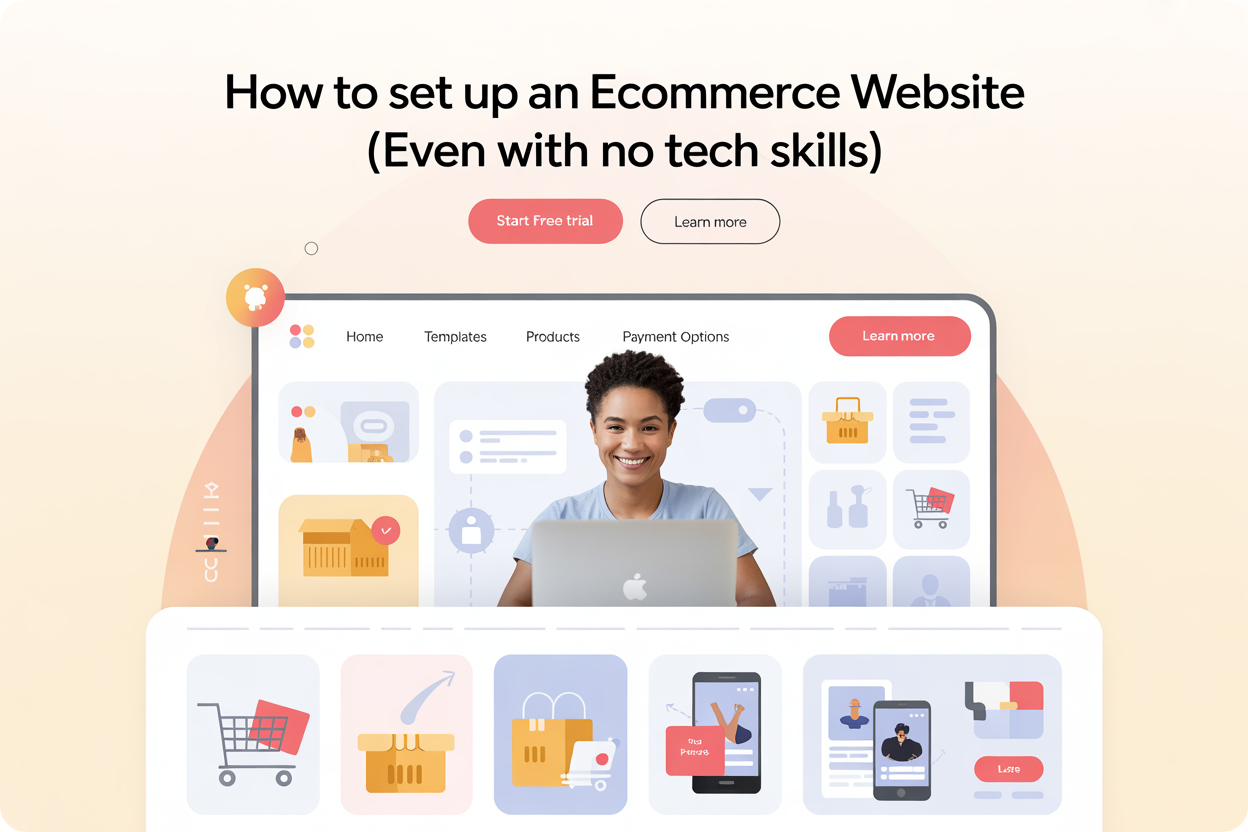Introduction
Starting your own online store might sound like a job for a tech guru, but here’s the truth—you don’t need a tech background to set up an eCommerce website anymore. With the rise of beginner-friendly tools, drag-and-drop builders, and easy-to-use platforms, you can launch your very own digital storefront in just a few hours. Whether you’re planning to sell handmade crafts, dropship gadgets, or offer digital products, this step-by-step guide will walk you through how to set up an eCommerce website (even with no tech skills).
1. Understanding the Basics of eCommerce
What Is an eCommerce Website?
An eCommerce website is a digital platform that allows people to buy and sell products or services online. These websites handle transactions, display product listings, manage inventory, and enable customer support—all in one place.
Types of eCommerce Models
There are several models to consider:
- B2C (Business-to-Consumer): Like Amazon or Shopify stores.
- B2B (Business-to-Business): Selling wholesale to other businesses.
- C2C (Consumer-to-Consumer): Peer-to-peer platforms like eBay.
- D2C (Direct-to-Consumer): Brands selling directly to buyers without intermediaries.
2. Choosing Your Niche and Products
Researching Profitable Niches
Not all products sell equally. Use tools like Google Trends, Amazon Best Sellers, or TikTok Trends to find high-demand, low-competition niches.
How to Choose Products to Sell
Ask yourself:
- Is there a pain point my product solves?
- Is there demand for it?
- Can I source or create it affordably?
3. Setting Goals and Budget
Estimating Costs
Here’s a rough breakdown:
| Item | Estimated Cost |
|---|---|
| Domain Name | $10–15/year |
| Hosting | $5–25/month |
| eCommerce Platform | $0–$29+/month |
| Design/Theme | Free–$100 one-time |
| Marketing | Variable |
Planning for ROI
Set SMART goals (Specific, Measurable, Achievable, Relevant, Time-bound). Example: “Reach $500 in sales in the first 30 days.”
4. Picking the Right eCommerce Platform
Shopify vs WooCommerce vs Wix
| Platform | Ease of Use | Best For |
|---|---|---|
| Shopify | ⭐⭐⭐⭐⭐ | Beginners |
| WooCommerce | ⭐⭐⭐ | WordPress users |
| Wix | ⭐⭐⭐⭐ | Creative design needs |
Best Platforms for Beginners
If you want simplicity, Shopify is ideal. No need to deal with hosting, coding, or security.
5. Securing a Domain Name
Tips for Choosing a Catchy Domain
- Keep it short and memorable.
- Avoid hyphens and numbers.
- Use keywords when possible.
Where to Buy a Domain Name
Trusted providers include:
- GoDaddy
- Namecheap
- Google Domains
6. Getting Web Hosting (If Needed)
Shared vs Dedicated Hosting
- Shared Hosting: Cheaper, great for beginners.
- Dedicated Hosting: More expensive, for high-traffic sites.
Best Hosting for eCommerce Sites
Look for:
- 99.9% uptime
- SSL support
- Good customer support (e.g., Bluehost, SiteGround)
7. Choosing a Template or Theme
Free vs Premium Themes
Free themes work well, but premium ones offer better customization and performance.
Responsive and Mobile-Optimized Design
Over 60% of online shopping happens on mobile—make sure your theme adapts well to all screen sizes.
8. Setting Up Your Online Store
Adding Products & Categories
Use high-quality images, detailed descriptions, and organized categories. This helps both users and SEO.
Optimizing Product Pages
Include:
- Keyword-rich product titles
- Clear CTAs (Add to Cart, Buy Now)
- Customer reviews
9. Setting Up Payments
Accepting Credit Cards, PayPal, Stripe
Most platforms integrate with:
- Stripe: Easy and fast
- PayPal: Globally trusted
- Square: Ideal for in-person + online sales
Securing Payment Gateways
Always use SSL (Secure Sockets Layer) to encrypt data.
10. Configuring Shipping Options
Domestic & International Shipping
Offer flat-rate, real-time, or free shipping to attract more buyers.
Setting Up Shipping Rates
Some platforms (like Shopify) integrate with UPS, USPS, and DHL for automatic rate calculations.
11. Creating Legal Pages
Privacy Policy, Terms & Conditions
Even if you’re just starting, these pages build trust and protect you legally. Most platforms have templates, or you can use free generators like TermsFeed.
Key pages to include:
- Privacy Policy: Explains how customer data is used.
- Terms & Conditions: Outlines the rules of buying from your site.
- Cookies Policy: Important for GDPR compliance.
Return and Refund Policy
Clear policies reduce disputes and improve customer satisfaction. Define:
- Timeframes (e.g., 30-day return)
- Conditions (e.g., unused items only)
- Refund method (store credit, full refund)
12. Adding Trust Signals
Trust is everything in eCommerce. If users don’t trust your site, they won’t buy.
Here’s how to boost your credibility:
- SSL Certificate: Shows “https” in your URL—essential for security.
- Customer Reviews: Social proof matters.
- Money-Back Guarantee: Lowers risk perception.
- Visible Contact Info: A real phone number or email increases confidence.
13. Optimizing for SEO
On-Page SEO Basics
On-page SEO helps your store get found on Google. Focus on:
- Title tags and meta descriptions
- Including keywords in product names and descriptions
- Using alt text on images
Using Keywords and Meta Tags
Do keyword research using tools like Ubersuggest or Google Keyword Planner. Then:
- Use 1 primary keyword per page
- Keep meta descriptions under 160 characters
- Add internal links to relevant products or blog posts
14. Launching Your Website
Pre-Launch Checklist
Before you go live, double-check:
- All links and buttons work
- Product pages are complete
- Payment processing is active
- Mobile responsiveness looks great
How to Announce Your Launch
Create hype with:
- A countdown on social media
- Early bird discounts or bonuses
- Influencer partnerships or giveaways
15. Promoting Your eCommerce Store
Using Social Media
Pick platforms based on your audience:
- Instagram for fashion & beauty
- Facebook for general audiences
- Pinterest for DIY or home decor
Post:
- Product showcases
- Behind-the-scenes content
- Customer testimonials
Email Marketing & Influencer Outreach
Email marketing = high ROI. Tools like Mailchimp and Klaviyo are easy to use. Build a list with:
- Pop-ups offering discounts
- Exit-intent offers
Partner with micro-influencers for authentic promotion at a low cost.
16. Managing Orders and Inventory
Setting Up Inventory Tools
Most platforms have built-in inventory features, or you can use third-party tools like:
- Oberlo (for dropshipping)
- Zoho Inventory
- ShipStation
Handling Orders Efficiently
Automate:
- Order confirmations
- Shipping notifications
- Inventory tracking
Make sure to respond to customer inquiries quickly—this improves your reviews and retention.
17. Tracking Performance and Scaling
Using Google Analytics
Track:
- Page views
- Cart abandonment rate
- Conversion rate
- Customer behavior
Use the insights to tweak pricing, test different product photos, or optimize copy.
How to Scale Your Store Over Time
Once sales come in:
- Launch new products
- Consider paid ads (Google, Meta)
- Explore international shipping
- Hire freelancers for design, copy, or customer service
Conclusion
Setting up your own online store may seem like a huge task, but with the right tools and guidance, you can do it—even with zero tech skills. Start small, learn as you go, and most importantly, take action. Don’t let fear of technology hold you back from launching your dream eCommerce business.
You’re only a few clicks away from owning a store that runs 24/7, selling products you believe in, to customers around the world.
Ready to Launch Your eCommerce Store Without the Tech Headaches?
At Sveneria, we specialize in helping non-tech entrepreneurs like you turn their ideas into fully functional online stores—without writing a single line of code. Whether you’re starting from scratch or need a digital overhaul, we’ve got your back.
Here’s how Sveneria can help you set up and grow your eCommerce website:
- Website Development: We build responsive, user-friendly, and high-converting eCommerce websites tailored to your brand and products.
- Branding & Design: From logo to color palettes, we’ll create a memorable brand identity that makes your store stand out.
- Search Engine Optimization (SEO): Get found on Google by your ideal customers with our expert SEO strategies.
- Content Marketing: We craft compelling product descriptions, blog posts, and guides that engage and convert.
- Landing Page Creation: Boost sales with custom-designed landing pages built to drive action.
- Analytics & Reporting: Know what’s working with detailed performance tracking and conversion analysis.
Let Sveneria bring your online store to life—tech-free, stress-free, and results-driven. Contact us today for a free consultation!





